 |
Viewfinder Diopter Allow you to see clearly through viewfinder. With supplied Multi-Meter Finder DP-30, adjusting the finder diopter enables near- or far-sighted photographers to adjust the eyepiece diopter within a continuous range of from -3 to +1. Pull the diopter adjustment knob and rotate it in either direction until the focused Image in 12mm-dia. circle within the viewfinder appears sharp, then push back to lock. |
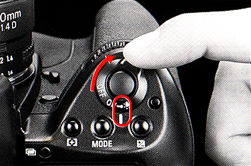 |
Illumination Switch Permit you to view LCD panels in the dark. In dim light, rotate Power/LCID panel illumination switch toward |
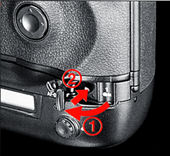 |
Using NON-DX Coded Film With non-DX coded film, rotate the Main-Command Dial while pressing the ( |
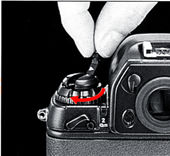 |
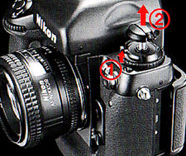 |
Film Rewind Crank 1. Manually Rewind Film. To rewind film manually, press the film rewind button |
* Frame counter counts backward when film is rewound manually with the meter on, * Do not press the shutter release button until the film leader is rewound completely back into the cartridge. Doing so may damage the shutter curtain.
Mirror Lock-up Lever -To lock reflex mirror in up position When using super-telephoto lenses or performing photomicrography, it is necessary to reduce camera vibration to the absolute minimum, Lock the reflex viewing mirror in the "up" position by rotating the mirror lockup lever counterclockwise until it stops.
 |
With the mirror lock up, you cannot operate the camera in any Auto Exposure or autofocus mode, even though the viewfinder LCD may indicate otherwise. Any indication of light in the LCD Is a result of spurious light entering through the viewfinder eyepiece. Note: When the reflex mirror is locked in the up position, make sure not to leave the camera in direct sunlight. The sunlight may enter through the lens and may damage the shutter curtain. |
Depth of Field Preview Button In Aperture-Priority Auto or Manual exposure mode, depress the depth-of-field preview button to stop the lens down to the aperture set with the Sub-Command Did, In Programmed Auto or Shutter-Priority Auto exposure mode, the lens will be stopped down to the automatically set aperture. The viewed image becomes progressively darker as the aperture gets smaller. Those portions of the picture that appear in focus when the button is pressed are within the depth of field.
 |
* During preview with lenses with meter coupler, attaining correct exposure is not possible, because exposure must be determined by full-aperture metering. * Use Metering system other than Spot, * During preview, aperture cannot be adjusted and autofocus is not possible, |
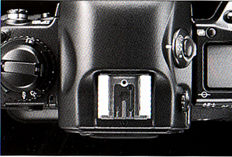 |
Accessory Shoe Located at the top of the Multi-Meter Finder DP-30, the ISO type hot shoe allows direct mounting of a wide range of Nikon dedicated electronic Speedlight, including SB-28, SB-27, SB-26, SB-25, SB-24, SB-23, SB-22s, SB-22, SB-20, SB-18, SB-1 6B and SB-15 (or other Nikon equivalent). Note: Other Nikon Speedlights may be mounted with a compatible Nikon flash unit coupler. |
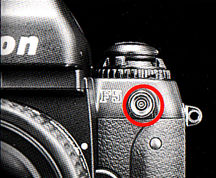 |
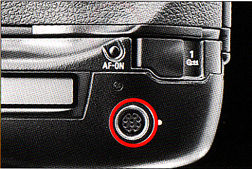 |
Sync (PC) Terminal The F5 features a separate sync terminal that accepts all standard PC-type plug-in sync cords. |
Operation with a Personal Computer When the F5 is connected to a MS Windows 95- or Apple's Macintosh- based personal computer via optional Personal
Computer Connecting Cord MC-33 or MC-34 and loaded with for MS@ Windows 95 or AC-1 ME for Macintosh Photo Secretary for F5, shooting information stored in the F5
can be downloaded to your personal computer. Also, downloaded shooting information can be linked to scanned image (from an image scanner) for editing on your personal
computer. For details, see Photo Secretary for F5 instruction Manual.
Remote control functions
* Downloading of function settings, exposure conditions and shooting information on the F5*.
* Additional Custom Settings are available. Various combinations of settings can be edited and stored.
* Exposure mode, Metering system, shutter speed or aperture settings can be selected on a personal computer.
* Selection of special shooting modes, such as Multiple Exposure, Interval Timer, Long Time Exposure, and simultaneous shooting on several camera bodies.
* Program Shooting in which combinations of various settings In preset order can be selected.
* Files in Program Shooting can be edited and stored.
* Shooting information data on each film roll can be downloaded and stored as a file.
* Shooting data of up to 80 rolls of 36-exposure films can be stored in the F5. The storage size can be doubled by increasing the memory.
| previous | NEXT | 10/18 Technical Issues, Interchangeable Backs & Focusing Screens
| Back to Index Page | Instruction Manual for Nikon F5
| Back | Main Index Page - Nikon F5 Professional SLR camera
The Camera - Background,
Issues & Summary
Basic
Features | Focusing | Metering Systems | Exposure Control | Reliability Issues | Nikkor lens Compatibility
Prisms/Finders - Index page
- 2 parts
Film Backs: Index
Page - 1 parts
Focusing Screens - Index
Page - 1 part
Flash System - Index
Page
- 3 parts
System Accessories: | Power Sources | Cases | Remote
Control | Miscellaneous
Macro
Photography
- Related info on Micro-Nikkor lenses
Technical Specification for Nikon F5
Main
Reference Map
/ Nomenclature
Resource Centre:
Instruction Manuals
Nikon
F5 Camera Body
- 18
parts
MF-28
Multi-Function Back
HTML - 8
parts
PC
Links - Photo Secretary
- 2
parts
AF-TTL Speedlights:
SB-28 / SB28DX | SB29(s) info | SB30 | SB50DX | SB80DX | SB600 info | SB800
Variants: F5 50th Anniversary Model | Nikon/Kodak DCS-620 | DCS-720 Digital Still SLR camera
| Nikon F | Nikon F2 | Nikon F3 | Nikon F4 | Nikon F5 | Nikon F6 | Nikkormat / Nikomat | Nikon FM | Nikon FE/ FA | Nikon EM/FG/FG20 | Nikon Digital SLRs | Nikon - Other models |
The Eyes of Nikon:-
Nikon Auto Focus Nikkor lenses:- Main
Index Page
Nikon Manual Focus Nikkor lenses:- Fisheye-Nikkor Lenses - Circular | Full Frame |
Ultrawides Lenses - 13mm15mm18mm20mm | Wideangle Lenses - 24mm28mm35mm | Standard Lenses - 45mm 50mm 58mm | Telephoto
Lenses - 85mm105mm135mm180mm & 200mm | Super-Telephoto Lenses - 300mm 400mm 500mm 600mm 800mm 1200mm |
 Index Page |
Special
Application lenses: Micro-Nikkor Lenses - 50mm~55mm -60mm 85mm -105mm 200mm Micro-Zoom 70-180mm Perspective Control (PC) - 28mm 35mm PC-Micro 85mm Dedicated Lenses for Nikon F3AF: AF 80mm f/2.8 | AF 200mm f/3.5 EDIF Depth of Field Control (DC): 105mm 135mm Medical Nikkor: 120mm 200mm Reflex-Nikkor Lenses - 500mm 1000mm 2000mm Others: Noct Nikkor | OP-Nikkor | UV Nikkor 55mm 105mm | Focusing Units | Bellows-Nikkor 105mm 135mm Nikon Series E Lenses: 28mm35mm50mm100mm135mm | E-Series Zoom lenses: 36~72mm75~150mm70~210mm |
MF Zoom-Nikkor Lenses: 25~50mm | 28~45mm | 28~50mm | 28~85mm | 35~70mm | 36~72mm E | 35~85mm | 35~105mm | 35~135mm | 35~200mm | 43~86mm | 50~135mm | 50~300mm | 70~210mm E | 75~150mm E | 80~200mm | 85~250mm | 100~300mm | 180~600mm | 200~400mm | 200~600mm | 360~1200mm | 1200~1700mm
Tele-Converters: TC-1 | TC-2 | TC-200 | TC-201 | TC-300 | TC-301 | TC-14 | TC-14A | TC-14B | TC-14C | TC-14E | TC-16 | TC-16A | TC-20E
Recommended links to understand more technical details
related to the Nikkor F-mount and production Serial Number:
http://rick_oleson.tripod.com/index-153.html by: my
friend, Rick Oleson
http://www.zi.ku.dk/personal/lhhansen/photo/fmount.htm by: Hansen,
Lars Holst
http://www.mir.com.my/rb/photography/hardwares/nikonfmount/lens2.htm
http://www.photosynthesis.co.nz/nikon/serialno.html
| Back | Index Page of Digital
Nikon SLR cameras
|
Back | Main Index Page of Pictorial
History of Nikon SLR cameras
![]()
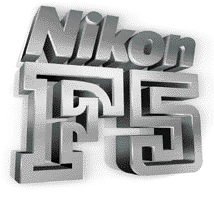 |
| Message Board | for Nikon F5 Series SLR model(s) | |
HOME - Photography in Malaysia |
![]()
A resource dedicated to my kids, Alvin Foo & Esther Foo- one day,
BOTH might need to use all these information for his/her Nikon F5A camera.
Volunteered Maintainer(s) for the Nikon F5 Message Board: Tony Davies-Patrick, UK; Rick Oleson, US; Koh Kho King, Malaysia.
Credit: Mr. Chuck Hester, US for his text re-editing skill for this site; Our staff, HowKiat® who created the 3D-Nikon F5 logo. Mr. Lew Chee Wai of YL camera for lending his F5 for me to take some shots appeared in this site. All those nice folks who have contributed their images, in particular Mr. Mike Long, Edwin leong, Palmi Einarsson, Sergio Pessolano, Fred Kamphues, Harry Eggens, Curtis Forrester, Nick (Natures Moments), Sandra Bartocha; fellow countrymen, Vincent Thian, Koh Kho King, Philip Chong, CY Leow etc. and contributions from a few nice folks from Photo Malaysia Forum. Disclaimers & acknowledgments: Certain content and images appeared in this site were either scanned from official marketing leaflets, brochures published by Nikon and/or contribution from surfers who claimed originality of their own work for public publishing in this website, where majority of the extracted information are used basing on educational merits. The creator of this site will not be responsible for any discrepancies that may arise from any possible dispute except rectifying them after verification from respective source. Neither Nikon or its associates has granted any permission(s) in using their public information nor has any interest in the creation of this site. "Nikon", "Nikkormat", "Nippon Kokagu KK" "Silent Wave", "Focus Tracking Lock-on", "Nikkor" & other applicable technical/business terms are registered trade name(s) of Nikon Corporation Inc., Japan. Site made with an Apple G5 IMac.